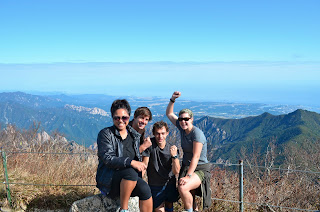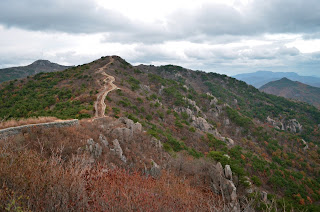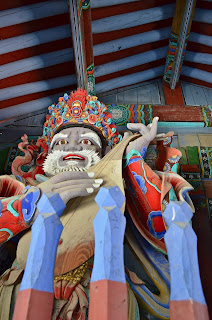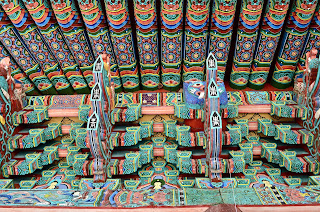I met my hiking group for the trip to Seoraksan National
Park while on the trip to Namhae Island back in September. I knew I had off 3
week days connected to the following weekend because of the Korean
“Thanksgiving” holiday called Chuseok.
Two of the guys on the Namhae trip, Brett and Matt, were planning to
meet a friend up in Seoraksan and they told me I could join if I would like. One
of the girls from the trip, Kristine, decided to join us as well. So began my
quest to find a tent in Jeonju.
I managed to track one down at a random store that rents
tents. I informed the man working in the shop via Google translate and hand
gestures that I would like to buy a two-man tent. He said that he could rent a
four person. I told him that I needed one to buy and he said, “Okay okay, you
buy here.” So I bought a “two-man tent” which turned out to be a roomy
three-man tent. Ahh, the details lost in translation.
After I was set with a tent, I got my travel plans figured
out. I would meet up with Matt, Brett, and Kristine at a jimjilbang in Seoul
Friday night, to leave for the east coast city of Sokcho early on Saturday
morning. The catch was that at this point I did not have a cell phone to help
with the Seoul rendezvous. I was not worried because I had my iPod that I can
get Wi-Fi on. I was not going to let my lack of cell phone derail my plans.
Korea is very wired so there is a ton of Wi-Fi everywhere, the catch is (as I
learned very quickly) that a lot of it is password protected, or you must be registered
with a particular cellphone company to use it.
I arrived at the express bus terminal in the southern area
of Seoul later than planned. If you can imagine the traffic jams in a city with
over 10 million people, you get the picture. I got into the bus terminal
expecting to find Wi-Fi and figure out where the rest of my group was.
Unfortunately, not the case. I knew which subway stop I needed to travel to
meet up with the group, so I headed that direction. I made it to the stop in
the eastern area of Seoul and wandered out of the subway station. Still no Wi-Fi.
No idea where I was meeting the gang, no dinner, and multiple hours of travel
started to get to me.
I wandered around in circles and after unsuccessfully trying
to purchase a Wi-Fi card at a few stores, I finally found Wi-Fi outside a
coffee shop. I figured out the name of the jimjilbang where the group was.
Their phones were not with them for me to message them, or they were dead, so
they were out of reach for navigation purposes. I asked a few Koreans if they
knew where it was and they attempted to direct me in the right direction
without successful results.
I was standing completely lost, disoriented and frustrated
stealing Wi-Fi to try to look up directions when a younger Korean couple walked
up to me. I felt a hand on my shoulder and the guy said, “Hello, do you need
help?” I almost screamed out of happiness. Jonathan (his English name) and his
adorable girlfriend informed me they went to college in Pohang, a coastal town
in southeast Korea, and they were traveling through Seoul for Chuseok. Not only
did Jonathan call the jimjilbang and get directions, him and his girlfriend
walked me to door of the jimjilbang and dropped me off to make sure I got there
okay. Incredible amounts of kindness from perfect strangers… this has become a
theme in Korea.
Korean cultural lesson time! You probably keep reading the
word “jimjilbang” and wondering what on earth that could be. Jimjilbangs are
incredibly popular with Koreans and some foreigners. They are essentially
public bathhouses that also offer heated floor space for people to sleep. The
bathhouse part is separated by gender. You shower first and then you can hang
out in giant hot bathtubs, freezing cold tubs to improve circulation, saunas, and
even get a massage from an old Korean women. After enjoying your bathhouse
session, you head to the co-ed area.
In larger jimjilbangs, like this particular one in Seoul,
there are a ton of amenities. This jimjilbang had rooms that were lined
entirely with minerals for healing purposes, ice rooms, oxygen rooms, Norebang
(private karaoke) rooms, TV rooms, a restaurant, etc. Jimjilbangs are open 24
hours and you pay about 7,000 won ($7) for the spa portion and a whopping
11,000 won ($11) for the combined spa and floor sleeping option. This
particular jimjilbang is actually one of the largest and more famous in Korea
from what I was told.
I arrived dazed and completely forgot what I had been told
about jimjilbangs until I walked inside and was surrounded completely by naked
Korean women. I got used to the notion of being naked in front of strangers and
enjoyed the perfect cure for a stressful day: a hot bath. This bath just
happened to include some strangers… relaxing nonetheless. After you get cleaned
up, you put on pajamas that are provided for you. The jimjilbang experience
might sound intimidating, but it’s strangely liberating. I have been to many
since and I enjoy going on a regular basis.
I found Kristine and we headed up to the co-ed area and
grabbed some dinner and after wandering around to all of the crazy rooms
(oxygen, silver, etc.), found a place to sleep. Our “pillows” were very hard
foam blocks; our blanket? The heated floor. Not optimal, but for four dollars,
who can really complain? We went to sleep in the quietest room we could find
with one other lady who was watching a PSY concert (think “Gangnam Style”) on
the big screen TV in the room.
Foggy Morning in Gangwando Province.
We woke up to a much larger population on the floor of the
jimjilbang. We found Brett and Matt and headed to the bus station to catch our
bus to Sokcho. Once we got to Sokcho we caught a bus to a ranger
station/entrance to Seoraksan National Park. We dropped our packs at the ranger
station and headed up Ulsanbawi (bawi means rock and Ulsan is a town in
southeastern Korea). The hike was short and steep. We got to see two temples on
the way up: one traditional and one that was literally in a rock. The view from
Ulsanbawi was spectacular. The rigid spine of the adjacent rock was the big
plus of the viewpoint, as well as the view of Sokcho and the coastline below.
If you look closely, you can see climbers!
After we hiked down Ulsanbawi, we met up with Andy, a friend
of Matts that would hike with us for the night, and sat down to eat before our
hike in to inner Seoraksan. We hiked about 8 km, increasing elevation,
following and crisscrossing the riverbed. We were attempting to make it to a
shelter as we were rapidly losing light, but after reading some signs and
consulting the map, we realized the spot where we had stopped to rest had
previously been a shelter that was no more. We were exhausted and there was an
area clear enough to pitch our three tents, so we dropped the packs and set up
camp. It was a good decision. The moon illuminated the rock face next to the
campsite and the stars were insanely bright. It was one of the better campsites
that I’ve ever spent a night.



We started our second day of hiking with a view of a waterfall
from above. The weather was just cool enough to keep us from sweating and the
sun was shining. The hike was steep and strenuous, but the views were worth the
work. Just when we thought we had seen the best of them, we would cross another
ridge and be astounded once more. We made it to what we thought was our shelter
for the night. It was, in fact, under construction. We hid our packs behind
some building materials and hiked down to a Bongjeongam Temple to have dinner. The temple
gave out dinner for free to all of the hikers that visited the temple. We sat
at the temple and ate the rice and seaweed soup as the sun dropped in the sky.















We got back to our packs at sunset and decided that we would
just try to camp around the building materials for the half constructed
shelter. One of the builders of the shelter lived in a small hut by the
building materials. He attempted to tell us in Korean with a bit of charades
that we couldn’t stay there, but we pointed to some Koreans who had set up camp
behind the building materials in protest of his prohibition and he eventually
relented. We set up the tents and watched twilight set in and the full moon
rise over the ridge.




Cultural note: the Chuseok holiday is a harvest festival
that coincides with the full moon of the eighth lunar month. The holiday is three days long and families
tend to have picnics around their ancestral gravesites where they pray to the
fallen family members and give offerings to the gods. Korean culture is
evolving though and now many families travel/go on hiking trips together for
Chuseok. Seoraksan was no exception to this holiday travel. The mountain was
crowded.
We woke up and attempted to watch the sunrise, but the neighboring ridge blocked the view. The moon had yet to drop behind the mountains and the dawn colors made it glow ghostly white. Our tent neighbors, a group of hardcore Korean hikers, were preparing a steaming breakfast feast of soup and rice as we looked on from our tuna cans and cold, precooked rice packets. The language barrier kept us from really getting a chance to talk to them, but they gave us soup, sausage and hot water to pour in our precooked rice. There were many smiles exchanged and we tried to share some of our food with them, but they kindly refused.
Hiking culture, no matter the language barrier or location,
tends to be a very altruistic culture. Along with the benefits of exercise,
tranquility, and otherworldly views, I think this is another thing that keeps
us all coming back for more.
After a wonderful breakfast, we packed up to summit Daecheongbong, our last summit of the trip and the highest summit within Seoraksan NP (the third highest in South Korea at 1,708 meters). Another beautiful day was unfolding before us and we all donned shorts and our windbreakers in the chilly morning air with the anticipation of warming up on the hike. I include this detail because the Koreans that we hiked past were beyond amazed that we would dare to wear shorts in the 45 to 50 degree Fahrenheit weather. We had people stop us and ask us if we were cold multiple times and a few groups even stopped to take our pictures. Oh Koreans, you never cease to amaze.




We finally made it to the summit of Daecheongbong and we
soaked in the views of the coastline and the autumn foliage flecked hills
below. The summit was covered in a bunch of boulders that were teeming with
people in every direction, but the 360-degree views of inner and outer
Seoraksan were ineffable. I would have been happy to end the hike there, but no
such luck.
We began the knee destroying decent that was essentially one steep staircase after another. We stopped for lunch at a waterfall with a few pools and then continued to head down. Our spirits were a bit broken by the end, but we knew we were headed to camp on the coast from there, so the motivation factor was there.
A depiction of one of the less steep parts of the hike down.
We crammed our outdoor-perfumed selves in a taxi with our
packs and headed to a beach on the coast by the name of Jukdo. The small
coastal town was full of surfers and the clear turquoise was a welcomed
blessing for my ocean-deprived soul. The salty smell and electricity in the air
carry nostalgia for me unlike any other.
Am I really in Korea?
We met up with some friends that had been roadtripping up
the east coast, and got down to the first order of business: finding food and
beer. We went to a small café that sold pizza and went to town. We bought beer
at the bar next to the café and the four of us were giggly with a buzz before
our pizza was even ready. After our feast, we set up our tents and visited a
tiny jimjilbang to wash off the previous 3 days and rejuvenate our tired bodies
in the hot baths. That night we got some makkoli (Korean rice wine), played a
pickup soccer game on the turf field next to the beach, and had a bonfire on
the beach where we cooked some fresh vegetables and meat. Not a bad way to end
a trip. The next morning after lounging on the beach and getting some Korean
food, we headed down south to Gangneung to catch the bus back to Jeonju.
Restaurant puppy wishing us farewell.
Chuseok weekend was one of my favorite weekends of my life
in Korea, and maybe ever. It was a weekend where somehow everything worked out
well. We caught the right buses, we encountered the right people, and the weather
was perfect. It was a weekend where everything that happened was exactly how it
should have happened. A serendipitous weekend.











































































